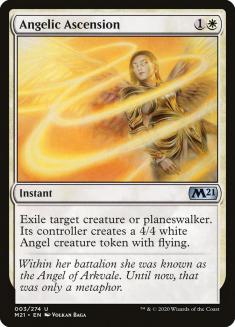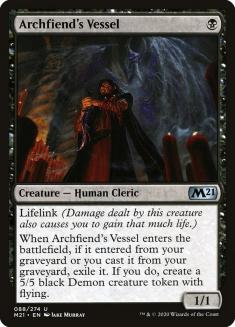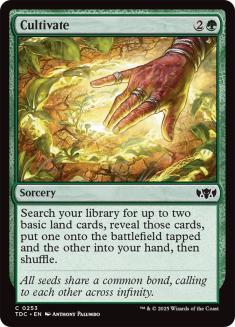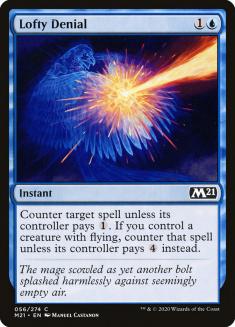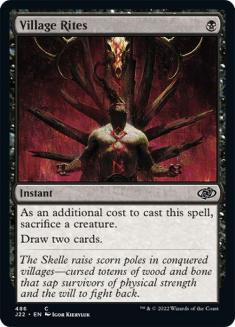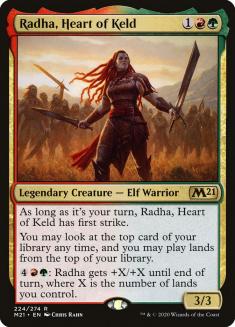Core Set 2021 preview season is over, and the set is due to arrive on the competitive scene later this week. With it comes our last, best hope of containing Temur Reclamation in Standard before this fall’s rotation, which I expect to be met with great anticipation by the Teferi, Time Raveler– and Wilderness Reclamation-loathing masses.
Evaluating the summer set for competitive play is always tricky because Standard is so well-established that it seems impossible for any new cards to break the stranglehold the known archetypes have on the metagame. But looking over Magic’s history, there’s plenty of precedent for late shake-ups. Field of the Dead and Sorin, Imperious Bloodlord turned Standard on its head last summer. Emrakul, the Promised End was the story of Pro Tour Eldritch Moon and vied with Collected Company for dominance, and Goblin Rabblemaster led red decks to upset the Devotion-dominated metagame from Theros Block Standard.
Yes, we’re coming off the most powerful years of Magic sets in recent memory, but Core Set 2021 is still going to deliver some impactful cards for the competitive scene. However, I’ve seen lots of hype around some cards that I believe will fall flat upon release, and others that are being mostly ignored that I expect to be in that group of majorly impactful cards.
Here are my picks for the most underrated and overrated cards in Core Set 2021.
Angelic Ascension: Underrated
This is not the kind of card that fits into any deck. But effects in this vein, because they offer such a high amount of flexibility, often are perfect role-players for decks that can mitigate the downside.
Most of the time, when white decks want to answer a planeswalker, they need to cast an enchantment costing three or more and hope they don’t get blown out by an Abrupt Decay or Reclamation Sage as the game progresses. And if they are playing counterspells, they have to leave a window open for their opponent to re-establish a battlefield advantage, leaving them untapping in a similar position anyway.
One of the reasons Elspeth Conquers Death is so powerful is that it mitigates both of these weaknesses, first by now allowing the exiled permanent to return, and second by rebuying a key creature or planeswalker in chapter three to catch up on the battlefield. But at five mana and only targeting expensive permanents, there’s still significant downside there.
Angelic Ascension is the cleanest possible answer to problematic creatures and planeswalkers, exiling any one at instant speed for the low cost of two mana. You just need to have a plant to answer the Angel token. Fortunately, there are some easy ones in Teferi, Time Raveler and Reflector Mage. Shatter the Sky is a reasonable solution as well, though giving your opponent an extra card is far from ideal.
I can see this card in Azorius Control decks that want to supplement their removal suite with such a flexible answer, as well as in more aggressive decks, which can use Angelic Ascension to clear away problematic permanents but also target their own permanents to create a surprise Angel. But as of yet, I haven’t seen a peep about this card. It’s a perfect role-player because it provides a unique effect for its color at an unprecedented level of efficiency.
Archfiend’s Vessel: Overrated
I’ve tried. Oh how I’ve tried. With cards like Call of the Death-Dweller and Lurrus of the Dream-Den to return Archfiend’s Vessel from your graveyard to the battlefield, and no shortage of ways to get it into the graveyard, it seems easy enough to get a solid payoff from this card in Standard, Pioneer, and even Modern.
But I’m afraid that Archfiend’s Vessel is the latest poster child for the danger of cool things. Because in a Teferi, Time Raveler and Brazen Borrower world, you shouldn’t be going out of your way and committing resources to make a creature token. There’s some merit to the argument that these cards aren’t particularly good against the rest of the cards that will surround Archfiend’s Vessel, but they aren’t horrible, so if you make them better, your opponents will leave them in.
Also, when evaluating this card, you have to consider how consistently you’ll realize the upside and just how bad the fail case is. In this case, getting the trigger isn’t too difficult, but the fail case is horrid. No one wants to put a 1/1 lifelink creature into their Constructed deck. Heck, few would want to put such a card in their Limited deck. Having such weak individual card means you won’t have much recourse when your opponent successfully disrupts your synergies, and with a relatively low upside, I don’t see it being worth the risk.
Cultivate: Overrated
I’m old enough to remember the days of Kodama’s Reach being a Constructed staple. Those days were a long time ago, and they aren’t coming back. Cultivate’s first run in Standard hardly set the world on fire, and it saw play exclusively next to an active volcano. Even Valakut, the Molten Pinnacle decks that were interested in flooding the battlefield with Mountains often eschewed Cultivate entirely or played a few copies.
So the pedigree here is a card that was a fine option, but not a necessary piece, in a deck that seems perfectly designed to utilize it. There’s some notion that Cultivate also performs well in a three-plus-color midrange deck, since it can ramp to your powerful cards while also providing mana fixing, but it’s far too inefficient for such a role. It also requires that you play a lot of basic lands, which isn’t ideal, and Fabled Passage only magnifies the issue. Maybe an eighty-card Yorion, Sky Nomad deck could make all the numbers work and want access to that much mana, but “narrow role-player” is far from where this card is being hyped.
The primary draw to Cultivate is the volume of cards it provides in the face of discard. If Kroxa, Titan of Death’s Hunger or Liliana, Waker of the Dead should grow more popular, Cultivate becomes more attractive. But it would take a very hard turn in that direction to make me look at Cultivate.
There are plenty of better ramp options available in Standard right now. Maybe after rotation this becomes the best available and Ugin, the Spirit Dragon is a good enough payoff to want to be a ramp deck, but Uro is still going to be around, and I’d rather supplement it with Solemn Simulacrum to play some defense against aggro decks.
Cultivate isn’t a flagship ramp spell in 2020. It’s a role-player that fills out your deck or helps in specific metagames where the extra land drops are valuable.
Lofty Denial: Underrated
There are lot of great counterspells around right now, but they all have significant holes. Mystical Dispute only targets blue spells, so it misses Wilderness Reclamation and Inverter of Truth. Dovin’s Veto and Negate are weak against aggro decks. You get the idea.
These counterspells are powerful enough that they see plenty of play despite their restriction, but they play much better in reactive decks where other answers can catch what they miss. As a devotee of blue aggro decks, I loathe Mystical Dispute. It’s hard for a proactive deck to maindeck too many copies because it needs its counterspells to be live against a wide range of matchups.
Lofty Denial is particularly good in aggressive blue decks because they typically have plenty of flyers to power it up, and the time when you’re least likely to have a flyer on the battlefield is in the early game when an overcosted Force Spike will often get the job done anyway. Compare this to Lookout’s Dispersal and Wizard’s Retort, which are more restrictive and often uncastable on Turn 2.
With Brazen Borrower and Shark Typhoon around I can see Lofty Denial seeing play in Standard, but I’m most excited about its potential to elevate blue aggro decks in Pioneer. Consider the following list:
Creatures (19)
- 4 Siren Stormtamer
- 1 Pteramander
- 4 Spectral Sailor
- 4 Brineborn Cutthroat
- 4 Brazen Borrower
- 2 Sea-Dasher Octopus
Lands (21)
Spells (20)
Sideboard

The top decks in Pioneer right now don’t have a lot of early disruption to stop your Curious Obsession draws, but all of them can go over the top of you with different cards. Mono-White Devotion and Dimir Inverter have their combos, control decks have Supreme Verdict and powerful planeswalkers, and then there are aggro decks to contend with. Lofty Denial provides the flexible answer that forms the base of your counter suite, and with thirteen flyers, it’ll be a powered-up Mana Leak more often than not.
Maybe I’m biased (read: I’m very biased) towards the blue aggro decks I love, but Lofty Denial is perfect for this strategy as well as similar decks like Spirits of all types or Standard Flash decks which can feature Spectral Sailor, Brazen Borrower, and Shark Typhoon to turn it on. When you’re playing a threat-dense strategy, you naturally don’t have as much room for answers, so flexibility in the answers you play is important. Lofty Dismissal provides that flexibility while sacrificing little in the way of efficiency. Look for it to make some noise.
Village Rites: Overrated
When I first read this card, I was unimpressed. Altar’s Reap was always much better in theory than in practice, and its many variants have been little better than filler cards in Limited. But on second thought, the difference between two and one mana is absolutely huge, and could easily push this card into a realm that Altar’s Reap could only dream of. I likened it to Thoughtcast as an efficient card draw spell for an aggressive deck provided you play it in the right shell.
But ultimately, I landed back where I started. Since the halcyon days of its youth, Thoughtcast has been outclassed in artifact decks by other payoffs, and I expect Village Rites to meet a similar fate. It’s a fine payoff card on rate, but when you’re talking about building around any kind of synergy, whether artifacts, tribal, or sacrifice, you need to be playing the most powerful payoffs available. When you add in all the supporting pieces to make the deck function consistently, the second-rate payoffs end up as casualties of space.
Cultivate isn’t a flagship ramp spell in 2020. It’s a role-player that fills out your deck or helps in specific metagames where the extra land drops are valuable.
In Rakdos and Jund Sacrifice in Standard, you can’t cut too many creatures, and you’re certainly not going to cut payoffs like Claim the Firstborn or Bolas’s Citadel. These decks, especially Jund, play plenty of card advantage already, and aren’t interested in similar, weaker effects.
Then I think of Village Rites in Abzan Rally in Pioneer. You have plenty of great creatures to sacrifice to it, and it could help dig toward your key payoff cards or extra copies of Cruel Celebrant to drain the opponent out the hard way. But it also interferes with your ability to mill over creatures and potentially sets back your development, making Return to the Ranks more difficult to cast. Ultimately, I’d be interested in trying a couple of copies, but it’s not moving the needle for a deck that has proven to be a flash in the pan.
When it comes to payoffs cards for synergy-driven archetypes, power is more valuable than efficiency, and that’s going to be the story of Village Rites.
Radha, Heart of Keld: Underrated
The last card on my list today, Radha, Heart of Keld is also the one I’m least confident about. But the two previous times we saw this effect on a creature, Oracle of Mul Daya and Courser of Kruphix, we had two format staples on our hands.
Radha is worse than both of its predecessors for many reasons, from being legendary and multicolored to matching up poorly against the common removal of the era. But playing lands from the top of your library is still a very powerful effect and allows Radha to gain immediate advantage in the face of efficient removal.
And while its second ability is also mediocre in comparison to Courser and Oracle, it’s still a net positive. We associate Courser of Kruphix with midrange decks like Abzan and Sultai Whip, but it was also a key component of the Gruul/Jund Monsters archetype, where it protected valuable planeswalkers, helped you hit your land drops, and combined with Domri Rade to form a powerful card advantage engine.
With a powerful aggressive high-end composed of Terror of the Peaks and Garruk, Unleashed, I could see a Gruul deck making its way back into Standard, and Radha would be well at home in such an archetype. And while being two colors will keep it from being a format staple, Gruul having sole access to such a powerful effect would be a huge boon to the color combination as a whole.
Early in this preview season, I was pessimistic about Core Set 2021’s ability to impact competitive Magic, but I’ve grown more bullish in the last week or two. In particular, I think the set favors aggressive decks, which have been lagging behind for much of the last year. I’m looking forward to seeing what other players come up with after a few weeks of testing on VS Live! and I’ll see you for the next preview season in three months … or two weeks … or a year and a half. I don’t know when the next set comes out and time is an illusion anyway.


